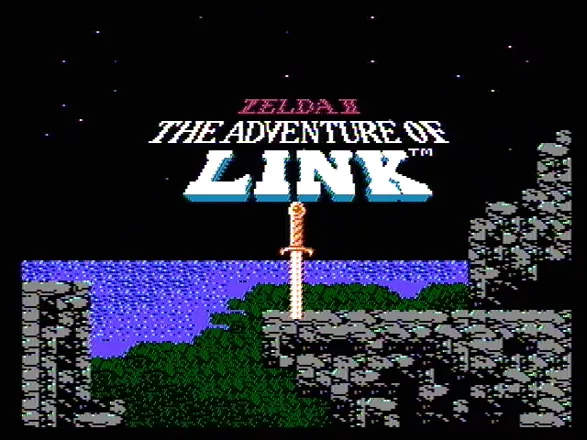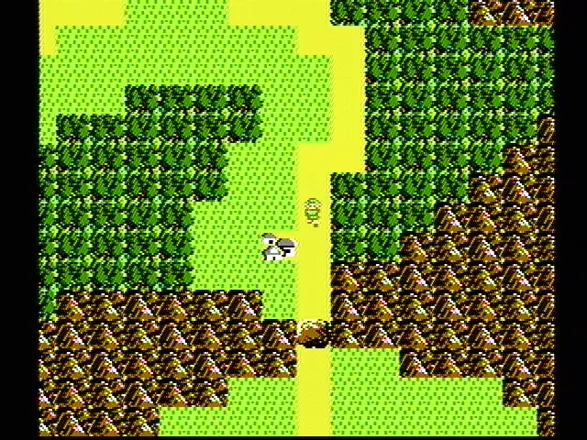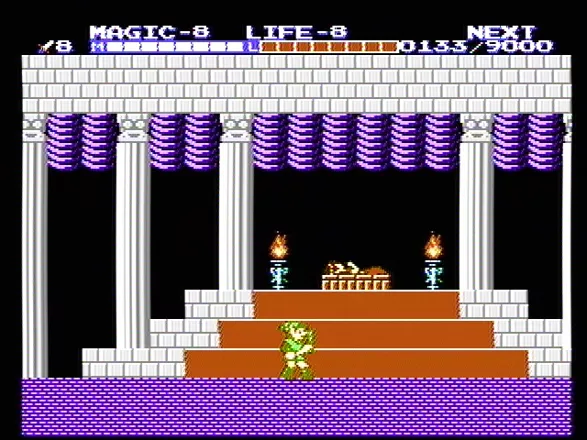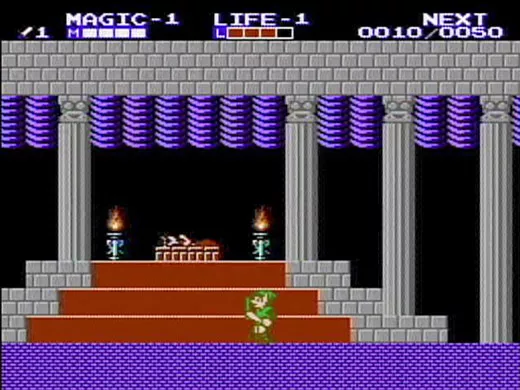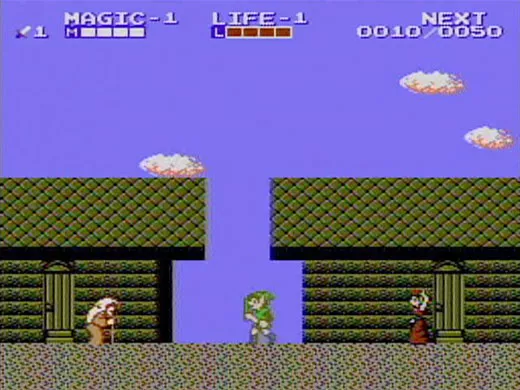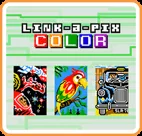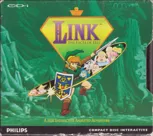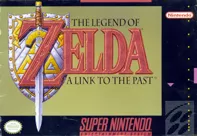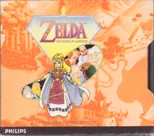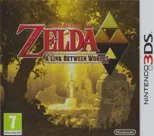Zelda II: The Adventure of Link
Description official descriptions
Link has just turned sixteen, and discovers a strange birthmark on his hand. With the help of Impa, Zelda's nursemaid, Link learns that this mark is the key to unlock a secret room where Princess Zelda lies sleeping. When young, Princess Zelda was given knowledge of the Triforce of power which was used to rule the kingdom of Hyrule, but when a magician unsuccessfully tried to find out about the Triforce from Zelda, he put her into an eternal sleep. In his grief, the prince placed Zelda in this room hoping she may wake some day. He ordered all female children in the royal household to be named Zelda from this point on, so the tragedy would not be forgotten. Now, to bring Princess Zelda back, Link must locate all the pieces of the Triforce which have been hidden throughout the land.
Each piece of the Triforce is in a temple guarded by a powerful monster which must be defeated. At the same time, Ganon's underlings are still around and gaining in strength and number. It is said Ganon could be brought back to life by sprinkling the blood of the one who defeated him on the ashes - which was Link himself.
Zelda II: The Adventure of Link is an action role-playing game, and a sequel to The Legend Of Zelda. The gameplay alternates between a top-down view (when traveling the land) and side-scrolling perspectives (when fighting, in a temple, or town). In the top-down view, Link cannot do much except for walking: in the side-scrolling action view, however, he can fight, cast spells, collect items and talk to people.
When Link encounters an enemy in the wilderness, or enters a location which contains enemies, he can fight them with his sword. If Link is at full health, his sword can be thrown, but when he is hurt, he can only fight in melee. Link has a shield which protects him against some of the enemies' attacks if they strike the shield. Touching an enemy or getting hit by their attacks decreases Link's health. If he runs out of health, he loses a life. If he loses all his lives, it's Game Over. Link can replenish his health completely by encountering a fairy in the wilderness, or by using the services of a healer in a town.
Link also has a "magic" meter. He can cast spells (as long as he has learned them) if he has some magic power left. Spells cost a various amount of magic power. They have various effects: they cure Link, allow him to jump very high, shoot fireballs etc. The magic power meter can be refilled by collecting blue and red jars sometimes left behind by enemies.
When Link slays an enemy, it might leave behind an item, or give Link some experience. When Link gains enough experience, he gains a level, which allows him to buy weapon power, maximum magic, or maximum health upgrades for his experience points. The player can also decide not to buy anything and stockpile his experience points for later use.
There are some items to be found that are necessary to get past certain points in the game. The Adventure of Link features a battery backup so games can be saved without needing a password system.
Spellings
- リンクの冒険 - Japanese spelling
Groups +
Screenshots
Promos
Videos
Add Trailer or Gameplay Video +1 point
See any errors or missing info for this game?
You can submit a correction, contribute trivia, add to a game group, add a related site or alternate title.
Credits (NES version)
10 People
| Executive Producer | |
| Producer |
|
| Director |
|
| Designer |
|
| Sound Composer |
|
| Programmer |
|
| Director |
|
Reviews
Critics
Average score: 77% (based on 52 ratings)
Players
Average score: 3.4 out of 5 (based on 185 ratings with 11 reviews)
A vast departure from the original, sometimes different isn't always a good thing
The Good
I think I applaud the development team for trying something different. The game has even more RPG elements and some of those things made their way into subsequent releases (some of the named locations, fighting a dark version of yourself, etc..) but largely the concepts and ideas in this game were forgotten.
As much as I despised the combat, I did start to get a kind of Souls-like feeling with it. I would figure out the enemy's patterns and after I had died a few dozen times, I became adept at taking them on. Then another enemy was introduced that I couldn't figure out, so rinse and repeat.
The Bad
Well, the graphics are terrible. Even if you're a retro gaming fan, there's a lot not to like about the visuals. Link's sword, for example, is the same color as his skin. So, it looks like Link has a really messed up appendage. All of the towns look exactly the same except for maybe a color palette swap or a slight shift in position. The overworld map is bland and uninteresting.
NPC dialogue is confusing and provides almost no context or information. All of the NPCs look the same.
None of this would be as bad if the gameplay was any good. After all, the Castlevania series attempted a similar shift in format with Simon's Quest and it wasn't terrible. Unfortunately, Zelda 2 doesn't fare so well. The game is unfair, way more unfair than the original. Link's sword swipe is not very long so therefore you have to be super close to the enemy to hit it. Link's movement is as if he's on ice so when you stop you kind of slide just a tiny bit, which makes platforming a bit more challenging than it needs to be.
The bosses, while visually interesting, are random and seem to have no real connection to one another.
The Bottom Line
The Adventure of Link swings for the fences, I will say that much. They tried to do something different, unfortunately it just didn't work. I don't think the game is without merit, the leveling system is interesting, and a lot of the enemies and bosses looked pretty good. Everything else though was pretty bad. The game honestly felt like it wasn't finished and needed just a little more polish and balancing.
NES · by John Murphy (10) · 2022
Definitely the most challenging Zelda
The Good
Very, very challenging game. The side-scrolling parts make things much more difficult, especially later in the game; although, by dungeon #2, things have gotten pretty hard. This made for a very enjoyable game, especially when overcoming obstacles and accomplishing various objectives (getting items, raising levels, finishing underworld dungeons).
The Bad
Some parts of the game were just TOO difficult (i.e., Death Mountain -- getting the hammer...took me at least a week). The final dungeon (end of the game) is also very hard. By the time you get to the Thunderbird, you'll be lucky to have any life and magic left. Good luck beating him. I was never able to finish this game on the NES. It took me about 15 years from the time I bought it until the time I used cheat codes on a NES emulator to finish it. Using the original NES controller was almost impossible for this game. The NES Max helped a lot. The music is this game was also a little sub-par. Zelda 1's music was better, I thought.
The Bottom Line
A great sequel for Zelda 1. Play that game first (play it to death, since that is one of the greatest video games of all time), then get a hold of this. A step-up in challenge and graphics. Classic game.
NES · by J O (8) · 2004
The Good
The world is a lot smaller compared to the first Zelda game and I appreciated that. The world is a lot smaller, but also has more detail. The original had an impressive size, but everything just looked the same with only a few changes per screen. Here the screens have been removed and you just walk around Hyrule's areas, There are; swamps, forests, mountain and of course water. I'd say that sacrificing size for detail is a good thing, especially if the world is still quite huge afterwards.
The gameplay is a lot faster compared to the original Zelda, not only do you walk faster, but the fights are also a lot faster and harder. You have to duck, jump and stab in order to kill your opponent. Later on you also discover magic spells and new moves that make the fights even bigger and of course you run into new enemies with different tactics. Nearing the end of the game, each screen I left without taking damage felt just like beating the final boss.
The game has a nice balance between puzzles and fighting, for me at least, which means barely any puzzles and a lot of fighting. The only "puzzles" you do encounter are the temples which are very hard to navigate through and some areas like Death Mountain. This is the NES, so you can't really demand anything else. There are still a lot of secrets to find though and some are mandatory if you want to progress through the story.
The fact that Hyrule is at war is emphasized more in this game, in the original Zelda there weren't any villages or soldiers or anything else to give you the impression you were really saving something. The people in Zelda II beg for help when you talk to them and the soldiers try to help you by teaching you new moves. It's sad that Nintendo didn't keep using this because it's really nice to have the feeling you are doing something worth doing, Zelda games are still pretty awesome, but why say no to even more atmosphere?
The overall story is a little bit more original than in the first Zelda. In the first Zelda game all you had to do was save the princess from her captor, which wasn't really the best story ever written. Here you are trying to find the Triforce in order to wake up a Princess from a very long time ago. It's still not the most amazing story, but certainly an upgrade. Also nice is that you no longer play as a kid, but as an older Link, this way the evil that threatens to take over the kingdom seems just a little bit more threatening.
The Bad
The difficulty curve is all over the place, you start of pretty easy, aside from having to go through a tunnel which requires you to have the item you'll find in the temple on the other side, but after that there is a giant peak in the middle. After that peak (Death Mountain) it becomes easier again. The final boss is very hard, but it doesn't beat Death Mountain. A lot of people may not even make it to Death Mountain, so if you are planning to play through this, I wish you good luck.
It's you against an army of enemies and if you die three times, you are sent back to the start of the game. This is very annoying because it doesn't make the game harder at all, you just go back to what you were doing with fresh health. In the original Zelda you would just respawn at the start of the dungeon if you died, that was a good way to punish me for dying, this however is way too cruel. It's also a problem that the extra lives you find do not return after you picked them up, so if you die, that live is lost forever.
The Bottom Line
Zelda 2 is (one of) my favorite Zelda game(s) out there and for good reasons; the action is fast, the story is better and the puzzles are do-able. Aside from an unreasonably difficulty curve and some weird choices regarding lives, this is a very good game.
However the difficulty is still too much to ignore, so I have to warn people that unless they truly want to play this and know it is very hard, they might want to stay away from it. It's never fun to buy a game and feel like it wants to punish you for playing it, so if you don't want to put up with that, you might want to stick to the (not as hard) Legend of Zelda.
NES · by Asinine (957) · 2011
Discussion
| Subject | By | Date |
|---|---|---|
| One of my favourite NES games so far, I easily prefer it to Zelda 1 | Andrew Fisher (697) | Mar 27, 2024 |
| So this is the black sheep?.. | Unicorn Lynx (181780) | May 30, 2012 |
| Only one who like this more than the first? | Simoneer (29) | Jun 15, 2010 |
Trivia
Cartridge
Zelda II: The Adventure of Link was the only other Nintendo-licensed NES title to have the honor of being a gold cartridge besides the original Legend of Zelda.
ERROR
Inside a house within one of the towns is an NPC who simply says "I AM ERROR" when talked to. While many gamers at first found this to be a mistake in the code, there is another NPC later in the game that tells you Error knows a secret, proving that Error is his name and not an error.
It is possible that Error’s name was originally "Errol" (like the Australian-American actor Errol Flynn), but due to the letters "R" and "L" being allophones in Japanese, the programmers mistyped the name as "Error" in translating the game to English.
Platforming
As of 2005 Zelda II is the only game in the series to use a standard jump button that doesn't require the use of a power-up, or running off the side of a ledge to clear a gap.
Town names
Many of the villages share their names with characters from Ocarina of Time (Ruto, Rauru, Mido and Saria, etc.)
Interestingly enough, Ocarina of Time is considered to be the first Zelda game continuity-wise, so it's possible the villages are named in their honour, at least in the case of the Sages (Rauru, etc.).
Awards
- Electronic Gaming Monthly
- November 1997 (Issue 100) - ranked #72 (Best 100 Games of All Time)
Information also contributed by CaptainCanuck and Mark Ennis
Analytics
Upgrade to MobyPro to view research rankings!
Related Sites +
-
Classic NES Series for the Game Boy Advance
Covers the line-up of the new Game Boy Advance series of NES Classics. -
Howard & Nester do The Adventure of Link
A regular feature in Nintendo Power magazine, Howard & Nester was a comic strip about two game whizzes who would one-up each other, while disclosing hints and tips, in the settings of various recently-released games for the NES platform. In the March/April 1989 two-page installment, they figure out how to extend the bridge in Saria. -
OC ReMix Game Profile
Fan remixes of music from Zelda II: The Adventure of Link. -
RPG Classics Zelda 2 shrine
Contains extensive information on this game, including descriptions of bosses, items, magics as well as maps and a walkthrough. -
Video review of Zelda II: The Adventure of Link
The Angry Video Game Nerd, James Rolfe, reviews Zelda II: The Adventure of Link on NES. -
Zeldapower.com Forums
Message Board for all of the Zelda games
Identifiers +
Contribute
Are you familiar with this game? Help document and preserve this entry in video game history! If your contribution is approved, you will earn points and be credited as a contributor.
Contributors to this Entry
Game added by Servo.
Nintendo 3DS added by ResidentHazard. Wii U added by Michael Cassidy. Nintendo Switch added by Kam1Kaz3NL77. Game Boy Advance, Wii added by gamewarrior.
Additional contributors: Satoshi Kunsai, Jeanne, Guy Chapman, NH, Alaka, monkeyislandgirl, Pseudo_Intellectual, LepricahnsGold, Perfil Falso, Patrick Bregger, Thomas Thompson.
Game added September 28, 2002. Last modified February 1, 2024.

